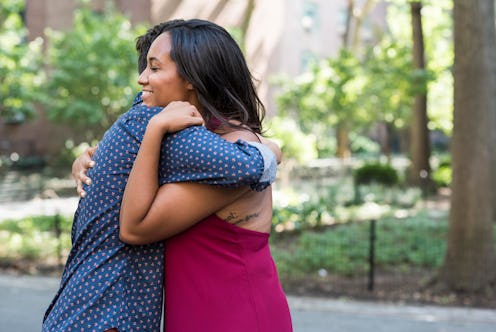Life
Being Nice To Someone Literally Makes Your Brain Light Up, Science Says

Being kind and helping others is a great way to boost your mood. However, the mechanisms of it have remained a bit obscure. Now, a new overview of brain studies published in NeuroImage has found, for the first time, what kindness looks like in the brain — and it's more complicated than anticipated. The scientists behind the study found that there are two distinct types of kindness, and they show up in the brain in different ways. And that has a lot of intriguing implications for how we understand the warm glow of being nice to somebody else.
The scientists looked at 36 different studies of kindness in which 1,150 separate participants had their brains scanned as they did something generous, thought about altruism, or some other action that triggered the 'kindness' centers of the brain. And the researchers divided the studies into the types of kindness on display. Type one is 'strategic' kindness, where you perform an act of generosity for somebody with the hope that you'll get something back in return: think, "I'll scratch your back if you scratch mine." Type two is 'altruistic', where you do good with no reward in sight, just for the feel-good factor.
It turns out that the feel-good factor is a real thing. Altruistic and strategic kindness, according to the brain scans, activate different segments of the brain. When you're being strategic, the striatal regions of the brain, which give feelings of reward, light up, and you get a rush of positive feelings. But when you're being generous without wanting anything in return, the brain also gives you feelings of reward — from some other areas.
Altruism, the scientists found, lights up a whole spectrum of the brain. It uses the striatal areas too, but it also activates the subgenual anterior cingulate cortex, which is involved in our mood, making us happy. Another area that shows a lot of activity when we're being generous? The ventromedial prefrontal cortex, which affects our decision-making and is a crucial part of making empathetic decisions that bond us to others. When you adopt a kitten or donate to a charity, that's your ventromedial prefrontal cortex talking.
The combination is pretty potent, and produces a very different glow of happiness and wellbeing to strategic kindness. Giving out of generosity, it turns out, is actually not very similar to using kindness as a transaction — and the feelings you get afterward reflect that.
The scientists behind the study point out in a press release that the two types of kindness do "overlap in the brain", so it's important to be careful and not confuse your motivations, or those of others. "If after a long day helping a friend move house, they hand you [money], you could end up feeling undervalued and less likely to help again," the scientists wrote. "A hug and kind words, however, might spark a warm glow and make you feel appreciated."
The glow of being kind to others is a pretty amazing thing, and one we all love. If you say you're doing a kindness for no reward but are really hoping for something in return, your brain definitely knows — and your feelings of happiness will reflect the difference.